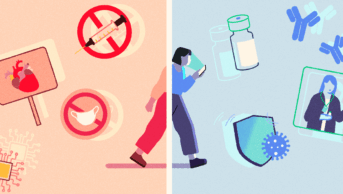
Philip Conaghan
Pharmacy teams have the potential to play a bigger role in front line assessment of joint pain. In the rheumatology clinic, the majority of individual diagnoses are made by taking a history — tests only play a small part and X-rays play a very small part in the diagnosis of joint pain conditions. With appropriate training, pharmacy teams can effectively categorise joint pain, allowing them to recommend best management options and signpost patients to relevant healthcare professionals and community/support services.
Musculoskeletal problems have a massive impact on an individual’s life and ability to work, particularly affecting their mobility and participation in valued activities[1],[2]. The impact on an individual’s life is much worse if the pain is not well controlled[3].
At present, musculoskeletal conditions make up at least 20% of primary care consultations in the UK and many people do not seek help. We need more front line workers if we are to successfully help with the problem of musculoskeletal pain.
Challenging existing perceptions
Joint pain and arthritis are often overlooked because they are commonly perceived as non-serious complaints, and people with chronic intermittent or persistent pain are often dismissed by the community or healthcare systems. A sense of ‘nothing can be done’ or ‘it’s just part of ageing’ pervades.
The idea among patients that nothing can be done is likely reflected in a large survey which reported that only 8.5% of osteoarthritis (OA) patients had used a pharmacist for advice on their condition[2], as well as little or no expectation of a new drug therapy (if the pharmacist is seen as the source for pharmacological therapies only). Yet it may also reflect reluctance by pharmacists to discuss joint pain, perhaps in part through an understandable lack of confidence in making a diagnosis.
Despite this, there are many reasons why pharmacists are ideally placed to be front line workers to help deal with the joint pain epidemic.
Pharmacists remain a trusted source of information in an increasingly overwhelmed healthcare service. Pharmacists are also in a unique position to know what medications people are taking and are very familiar with medication review processes, which have demonstrated benefit in managing knee pain[4]. They are also often in a unique position to know if patients are inappropriately using over-the-counter nonsteroidal anti-inflammatory drugs (NSAIDs).
Since much of the medical diagnosis of joint problems occurs through history taking, and treatments for most mechanical joint problems are very similar, pharmacists can help with musculoskeletal pain triage, or classification into a mechanical or inflammatory category.
Classification of joint pain
The role of pharmacy teams in distinguishing possible inflammatory arthritis, with its urgent need for treatment, from common mechanical joint problems is feasible with some background information, and identifying any ‘red flags’ that would require referral to either a GP or other specialist care (see Box).
Mechanical joint pain
While there are more than 100 different kinds of joint conditions, the vast majority of joint pains may be described as ‘mechanical’ — that is, they are associated with little morning joint stiffness and the pain gets worse with increasing and continued use as the day goes on. While much of this pain is attributed to OA (a joint structural problem associated with cartilage breakdown, subchondral bone damage and varying degrees of inflammation), it is also likely that some of this joint pain is related to tendon inflammation and to enthesitis (the location where tendons insert into bones). The important underpinning problem for most of these pains in older people is increasing muscle weakness caused by reduced activity levels and joint pain causing further disuse. In younger people, muscle weakness can be a result of office jobs and sedentary lifestyles, with tendonitis problems reflecting increased use of keyboards and electronic devices.
The general principles of management for many of these common conditions are the same: provide information/education, non-pharmacological therapies (most effectively a combination of initially muscle strengthening and flexibility, then aerobic exercises) and pharmacological therapies. The most effective therapy without side effects is muscle strengthening targeted at specific regions, such as quadriceps strengthening for knee pain. Pharmacists will be familiar with the limited range of pharmacological therapies for musculoskeletal problems: paracetamol, topical NSAIDs and capsaicin, oral NSAIDs and opioids. However, the analgesic effect of opioids seems to be of limited benefit in chronic musculoskeletal problems[5]
and there is potential for abuse, as highlighted by the current opioid crisis in the United States.
Inflammatory joint conditions
Inflammatory arthritides are much less common than mechanical joint pain — around 2.5% of the UK population have gout, around 1% of the UK population have rheumatoid arthritis, and other conditions are even less frequent, although each has the potential for a devastating impact on health. The modern mantra for the management of these conditions involves early detection, diagnosis by a rheumatologist and immediate treatment with pharmacological therapies, commonly methotrexate, hydroxychloroquine and sulphasalazine. Patients who are unresponsive to these therapies will be escalated to modern biologic therapies.
This separation into two types of problem is useful for directing therapy but is simplistic. Mechanical problems may have associated inflammation (e.g. a swollen knee caused by synovitis in a patient with knee OA) and joint pain in people with inflammatory arthritis can be worse with usage.
There are no absolute rules, of course, and persistence and severity — or increasing severity — of symptoms should result in medical consult. By taking a brief history, pharmacy teams can help categorise patients who would benefit from further evaluation (see Box).
Referral and signposting
The other major role that pharmacy teams can play is that of signposting people to appropriate advice about their conditions. An internet search for the term ‘osteoarthritis’ obtains more than 16 million results. While some of these sites are authoritative and evidence based, many are not. Therefore, signposting people to reliable sites, such as those from the NHS, Versus Arthritis (formerly Arthritis Research UK) or the National Rheumatoid Arthritis Society, would be valuable for most people with joint pain.
The tsunami of joint pain
Figures from the global burden of disease put OA as one of the fastest rising problems, together with diabetes[6]. A statistic unlikely to improve in our rapidly ageing and increasingly obese society.
For our healthcare system to realise the potential of pharmacy teams to become an important point of support for patients, pharmacy must realise the important role they have in supporting patients with joint pain. Likewise, recognition from patients that pharmacy can provide help and advice in managing their debilitating condition is also required.
Box: ‘Red flags’ that require medical referral
- The most important question to ask someone with joint pain is about the duration of joint stiffness in the morning. ‘Morning stiffness’ is defined as a difference in joint pain/stiffness between first getting out of bed and the patient reporting the joints feeling less stiff, or ‘freeing up’. It does not imply they become completely pain free. For OA, this is typically 5–10 minutes. For tendonitis in the hands, it may be 30 minutes. Anything more than 60 minutes should be assessed by a doctor as suspicious of inflammatory arthritis. If joint stiffness is present at the same severity all day, this means there is no morning stiffness.
- Presence of recent infections, usually diarrhoeal illnesses or a sexually transmitted infection. A small percentage of patients with these infections can develop a reactive inflammatory arthritis which tends to be in one or two large joints.
- Presence of concomitant diseases, especially psoriasis or inflammatory bowel disease: a small percentage of people with these immune diseases will develop inflammatory arthritis. A ‘sausage-shaped’ finger or toe in someone with psoriasis is generally indicative of psoriatic arthritis, as it represents a lesion called dactylitis.
- Some ‘red flag’ symptoms warrant referral to GP. Very acute back pain in an older female would raise the possibility of vertebral fracture secondary to osteoporosis, while back pain with a change in bladder/bowel habits (not just caused by increasing opioid use) warrants referral; increasing night pain requires consideration of underlying malignancy, and progressive pain from day-to-day in a single joint suggest joint infection. Sudden onset of bilateral shoulder and hip pain in people aged over 60 years warrants referral to a GP for consideration of polymyalgia rheumatica. Any acute-onset, hot, swollen joint warrants referral.
- Gout is the most common inflammatory arthritis and is often poorly managed. Pharmacists will often see people with flares of gout presenting for non-steroidal anti-inflammatory drugs and should be urging them to see their GP about starting hypouricemic therapy (e.g. allopurinol). For people already on hypouricemic therapy, any acute arthritis must be considered gout until proven otherwise. It is noteworthy that most people are not on an adequate dose of allopurinol, with the average dose required often more than 300mg — the single tablet so commonly used. Therefore, pharmacists can play a major role in optimising ongoing damage and pain from this type of arthritis.
Additional useful resources
- da Costa BR, Reichenbach S, Keller N et al. Effectiveness of non-steroidal anti-inflammatory drugs for the treatment of pain in knee and hip osteoarthritis: A network meta-analysis. Lancet 2017;390(10090):e21–e33. doi: 10.1016/S0140-6736(17)31744-0
- Duffield S, Ellis B, Goodson N et al. The contribution of musculoskeletal disorders in multimorbidity: Implications for practice and policy. Best Pract Res Clin Rheumatol 2017;31(2):129–144. doi: 10.1016/j.berh.2017.09.004
- March L, Smith E, Hoy D et al. Burden of disability due to musculoskeletal (MSK) disorders. Best Pract Res Clin Rheumatol 2014;28(3):353–366. doi: 10.1016/j.berh.2014.08.002
About the author:
Philip Conaghan is professor of musculoskeletal medicine and director of the Leeds Institute of Rheumatic and Musculoskeletal Medicine at the University of Leeds. He is a rheumatologist and deputy director of the National Institute for Health Research (NIHR) Leeds Biomedical Research Centre.
Conaghan is supported in part by the NIHR Leeds Biomedical Research Centre. The views expressed are those of the author and not necessarily those of the NHS, the NIHR or the Department of Health.
Supported by GlaxoSmithKline
GlaxoSmithKline provided financial support in the production of this content. The author was not paid to write this article and The Pharmaceutical Journal retained full editorial control at all times.
References
[1] Versus Arthritis (previously Arthritis Research UK). State of musculoskeletal health. Chesterfield: 2017. Available at: https://www.arthritisresearchuk.org/arthritis-information/data-and-statistics/state-of-musculoskeletal-health.aspx (accessed December 2018)
[2] Conaghan PG, Porcheret M, Kingsbury SR et al. Impact and therapy of osteoarthritis: The Arthritis Care OA Nation 2012 survey. Clin Rheumatol 2015a;34(9):1581–1588. doi: 10.1007/s10067-014-2692-1
[3] Conaghan PG, Peloso PM, Everett SV et al. Inadequate pain relief and large functional loss among patients with knee osteoarthritis: Evidence from a prospective multinational longitudinal study of osteoarthritis real-world therapies. Rheumatology (Oxford) 2015b;54(2):270–277. doi: 10.1093/rheumatology/keu332
[4] Hay E, Foster N, Thomas E et al. Effectiveness of community physiotherapy and enhanced pharmacy review for knee pain in people aged over 55 presenting to primary care: pragmatic randomised trial. BMJ 2006;333(7576):995. doi: 10.1136/bmj.38977.590752.0
[5] Krebs EE, Gravely A, Nugent S et al. Effect of opioid vs nonopioid medications on pain-related function in patients with chronic back pain or hip or knee osteoarthritis pain: The SPACE randomized clinical trial. JAMA 2018;319(9):872–882. doi: 10.1001/jama.2018.0899
[6] Vos T, Flaxman A, Naghavi M et al. Years lived with disability (YLDs) for 1160 sequelae of 289 diseases and injuries 1990–2010: a systematic analysis for the Global Burden of Disease Study 2010. Lancet 2012;380(9859):2163–2196. doi: 10.1016/S0140-6736(12)61729-2
You may also be interested in

Calling the shots: the pharmacists combatting vaccine misinformation

Embedding quality improvement in pharmacy practice: a departmental strategy at University Hospitals of Derby and Burton

